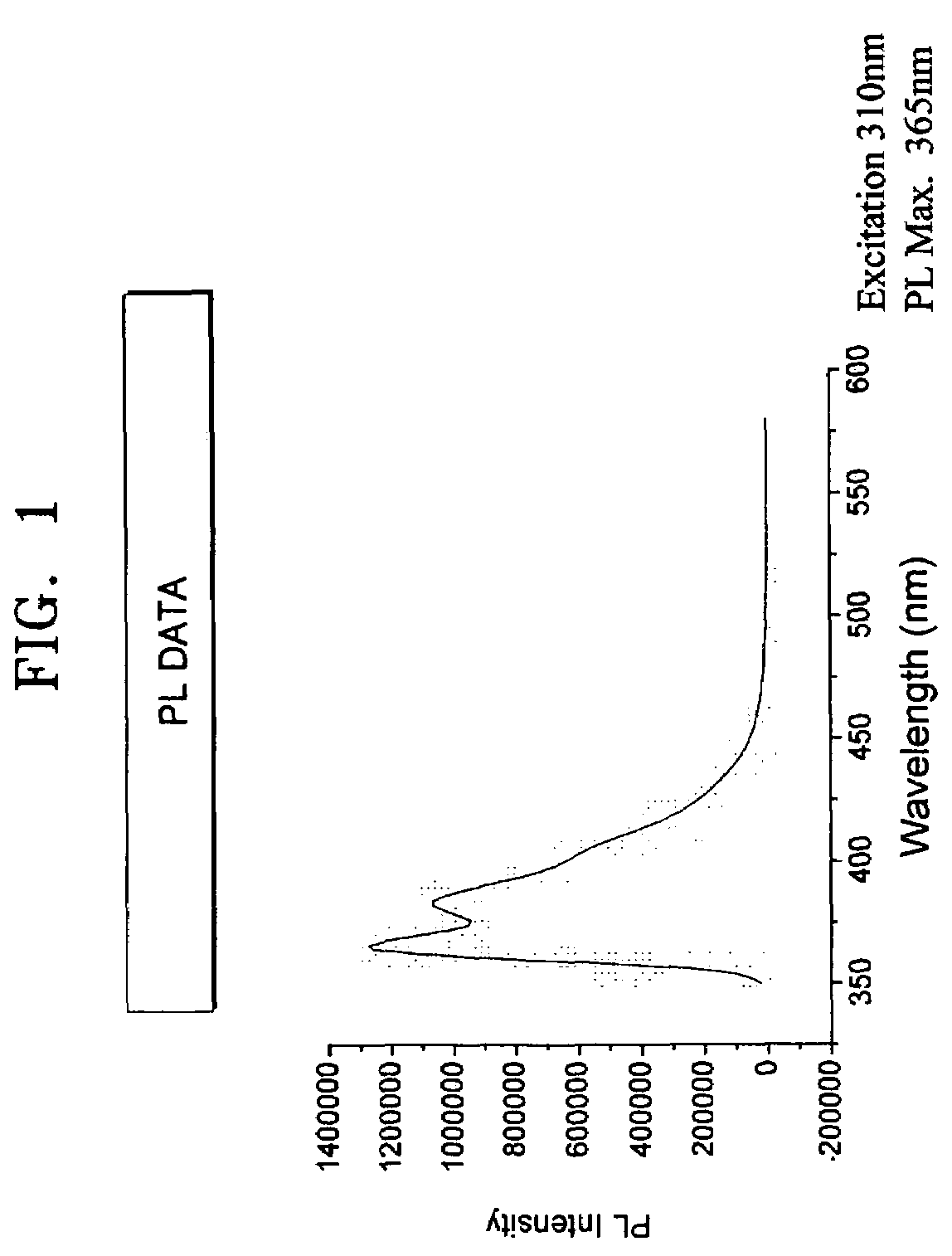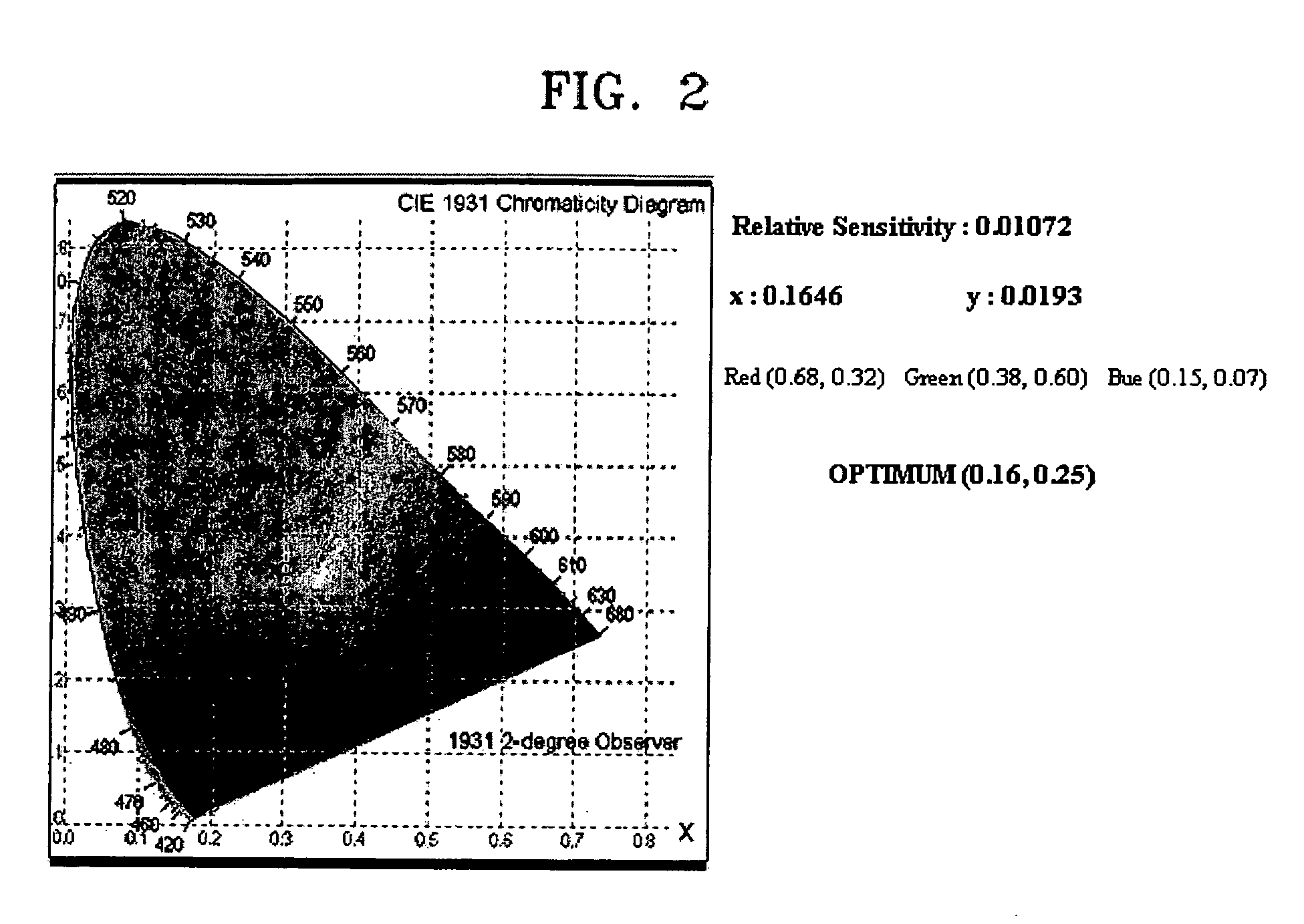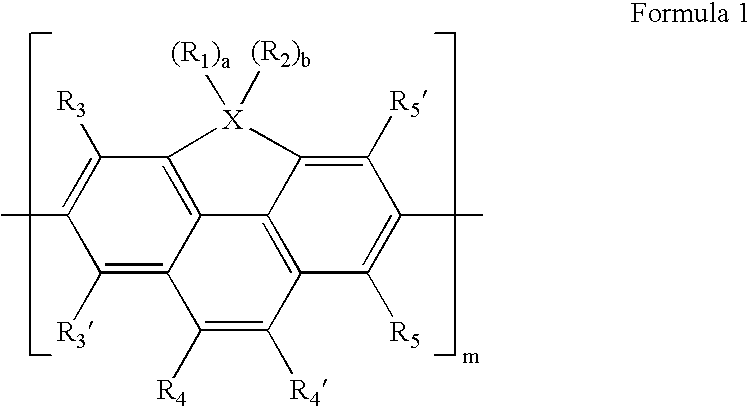Cyclopentaphenanthrene-based compound and organoelectroluminescent device employing the same
a technology of cyclopentaphenanthrene and compound, which is applied in the direction of solid-state devices, discharge tubes/lamp details, natural mineral layered products, etc., can solve the problems of unsatisfactory color purity, and achieve the effects of improving luminous efficiency, thermal stability and color purity
- Summary
- Abstract
- Description
- Claims
- Application Information
AI Technical Summary
Benefits of technology
Problems solved by technology
Method used
Image
Examples
specific example 1
Synthesis of 4,4-dioctyl-cyclopenta[def]phenanthrene
[0042]3 g (15.76 mmol) of cyclopenta[def]phenanthrene and 7.74 ml (44.80 mmol) of octylbromide were dissolved in 300 ml of tetrahydrofuran. 94.68 ml of 1M potassium t-butoxide was slowly added dropwise thereto, heated at 50° C., stirred for 1 hour, and concentrated under reduced pressure to remove tetrahydrofuran. Then, 300 ml of ethylacetate was added to the reaction mixture for extraction, and then washed with brine. The resultant product was washed once with distilled water, and an ethylacetate layer was dehydrated using MgSO4, followed by filtering and concentrating under reduced pressure. The produced mixture was isolated by silica gel column chromatography (eluent: hexane), giving 4.68 g of the target product, 4,4-dioctyl-cyclopenta[def]phenanthrene, at a yield of 71.67%.
[0043]The compound was characterized using proton NMR as follows: 1H-NMR(CDCl3): ppm, 0.80(m, 10H, octyl), 1.07-1.25(m, 20H, octyl), 2.10-2.17(m, 4H, octyl),...
specific example 2
Synthesis of 4,4-dioctyl-2,6-dibromocyclopenta[def]phenanthrene
[0044]3 g (7.2 mmol.) of 4,4-dioctyl-cyclopenta[def]phenanthrene as prepared in Example 1 was added to a reaction flask and was dissolved in 50 ml of methylene chloride. Then, as the reaction was kept in the dark, a solution obtained by diluting 0.74 ml of bromine in 37 ml of methylene chloride at room temperature was slowly added dropwise to the reaction mixture. After adding dropwise, the reaction mixture was stirred for about 30 minutes and then concentrated under reduced pressure. The produced mixture was isolated by silica gel column chromatography (eluent: hexane), giving 2.17 g of the target product, 4,4-dioctyl-2,6-dibromocyclopenta[def]phenanthrene at 52.5% yield.
[0045]The compound was characterized using proton NMR as follows: 1H-NMR(CDCl3): ppm, 0.80(m, 10H, octyl), 1.07-1.21(m, 20H, octyl), 2.10-2.14(m, 4H, octyl), 7.35(d, 1H, aromatic), 7.53(d, 1H, aromatic), 7.65(t,H, aromatic), 7.79(d, 1H, aromatic), 7.82,...
specific example 3
Synthesis of poly(dioctycyclopentaphenanthrene)
[0046]First, a Schlenk flask was vacuumed and refluxed with nitrogen gas several times to completely remove the moisture. Then, 480 mg (1.7 mmol) of bis(1,5-cyclooctadiene)nickel(O) and 273 mg (1.7 mmol) of 2,2′-bipyridine were charged into the Schlenk flask in a glove box. The flask was then vacuumed and refluxed several times using nitrogen gas. 4 ml of anhydrous dimethyl formamide (DMF), 0.2 ml of 1,5-cyclooctadie (COD) and 5 ml of anhydrous toluene were then added to the flask under a nitrogen atmosphere. After the mixture was stirred at 70° C. for 30 minutes, a solution obtained by diluting 500 mg (0.873 mmol) of 4,4-dioctyl-2,6-dibromocyclopenta[def]phenanthrene as prepared in Example 2 in 8 ml of toluene was added to the reaction mixture. The reaction mixture was refluxed at 70° C. for 24 hours and cooled to room temperature.
[0047]The reactant was treated with an acid solution, e.g., a mixed solution comprising HCl, acetone and m...
PUM
| Property | Measurement | Unit |
|---|---|---|
| thickness | aaaaa | aaaaa |
| temperature | aaaaa | aaaaa |
| emission peak | aaaaa | aaaaa |
Abstract
Description
Claims
Application Information
 Login to View More
Login to View More - R&D
- Intellectual Property
- Life Sciences
- Materials
- Tech Scout
- Unparalleled Data Quality
- Higher Quality Content
- 60% Fewer Hallucinations
Browse by: Latest US Patents, China's latest patents, Technical Efficacy Thesaurus, Application Domain, Technology Topic, Popular Technical Reports.
© 2025 PatSnap. All rights reserved.Legal|Privacy policy|Modern Slavery Act Transparency Statement|Sitemap|About US| Contact US: help@patsnap.com



